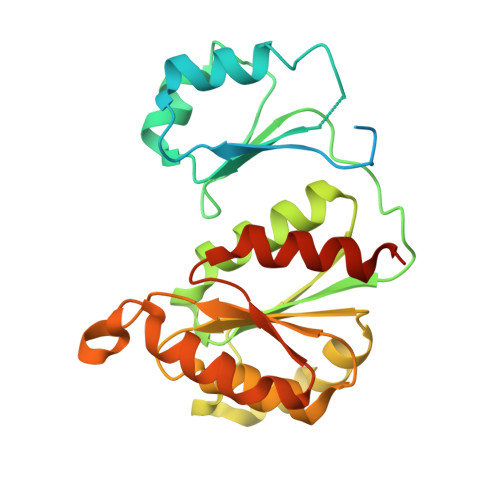The LarB carboxylase/hydrolase forms a transient cysteinyl-pyridine intermediate during nickel-pincer nucleotide cofactor biosynthesis.
Rankin, J.A., Chatterjee, S., Tariq, Z., Lagishetty, S., Desguin, B., Hu, J., Hausinger, R.P.(2021) Proc Natl Acad Sci U S A 118
- PubMed: 34548397
- DOI: https://doi.org/10.1073/pnas.2106202118
- Primary Citation of Related Structures:
7MJ0, 7MJ1, 7MJ2 - PubMed Abstract:
Enzymes possessing the nickel-pincer nucleotide (NPN) cofactor catalyze C2 racemization or epimerization reactions of α-hydroxyacid substrates. LarB initiates synthesis of the NPN cofactor from nicotinic acid adenine dinucleotide (NaAD) by performing dual reactions: pyridinium ring C5 carboxylation and phosphoanhydride hydrolysis. Here, we show that LarB uses carbon dioxide, not bicarbonate, as the substrate for carboxylation and activates water for hydrolytic attack on the AMP-associated phosphate of C5-carboxylated-NaAD. Structural investigations show that LarB has an N-terminal domain of unique fold and a C-terminal domain homologous to aminoimidazole ribonucleotide carboxylase/mutase (PurE). Like PurE, LarB is octameric with four active sites located at subunit interfaces. The complex of LarB with NAD + , an analog of NaAD, reveals the formation of a covalent adduct between the active site Cys221 and C4 of NAD + , resulting in a boat-shaped dearomatized pyridine ring. The formation of such an intermediate with NaAD would enhance the reactivity of C5 to facilitate carboxylation. Glu180 is well positioned to abstract the C5 proton, restoring aromaticity as Cys221 is expelled. The structure of as-isolated LarB and its complexes with NAD + and the product AMP identify additional residues potentially important for substrate binding and catalysis. In combination with these findings, the results from structure-guided mutagenesis studies lead us to propose enzymatic mechanisms for both the carboxylation and hydrolysis reactions of LarB that are distinct from that of PurE.
- Department of Biochemistry and Molecular Biology, Michigan State University, East Lansing, MI 48824.
Organizational Affiliation:


















